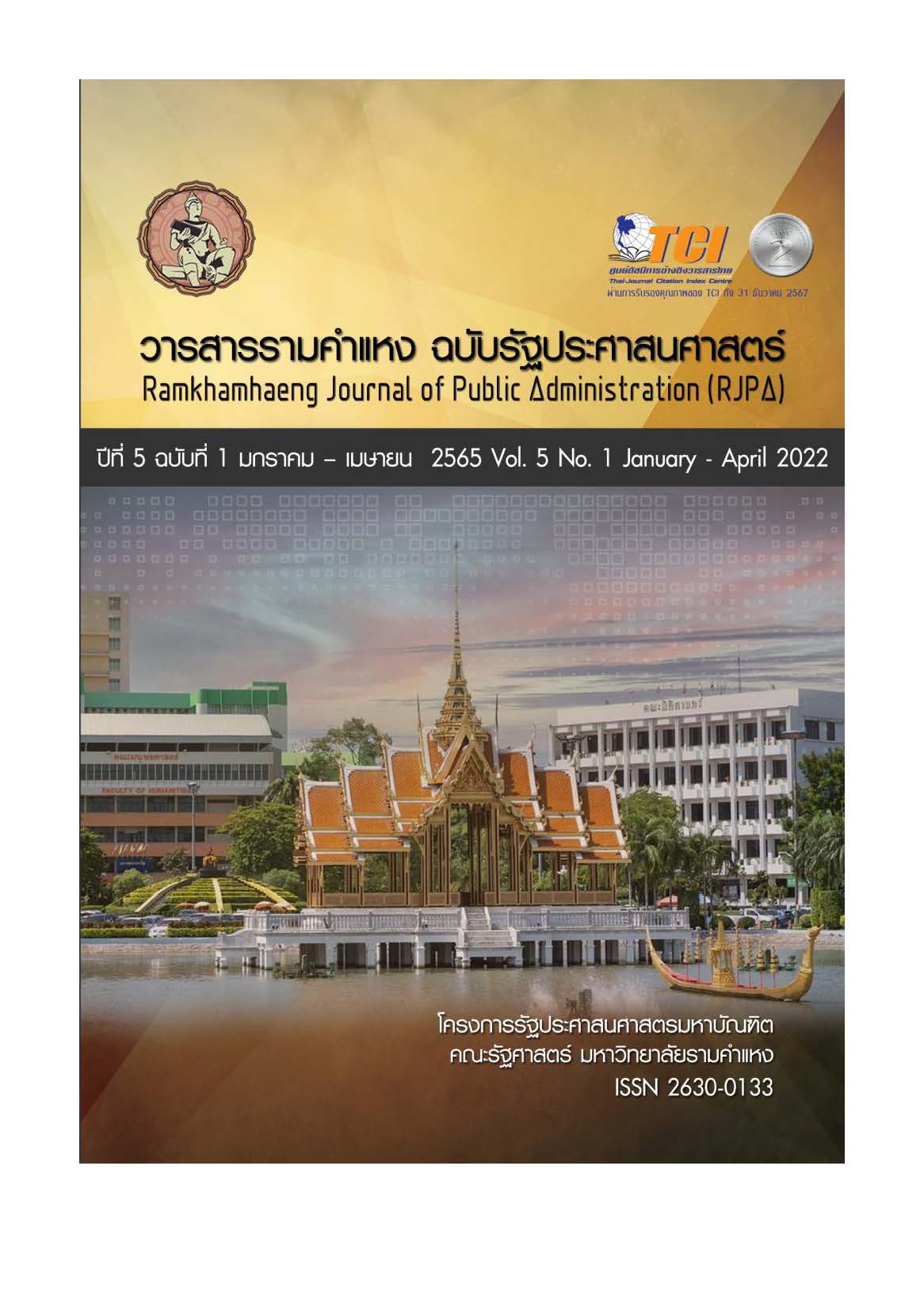Increase Capacity of Proactive Community Relations of Work to Create a Modern, Livable Community in the Amphawa area Samutsongkhram Province
Keywords:
increase capacity, proactive community relations work, livable community, modern communityAbstract
This research article has 2 objectives, i.e. (1) to study the capacity of proactive community relations work and (2) to study the application of modern technology as solutions to safety threats to people's lives and properties. The sample group consists of chief police officers of Amphawa police station, police officers, engaging in proactive community relations work of Amphawa police station, executive administrators of relevant agencies regarding proactive community relations work and the people. The researchers gather information in many aspects. A tailored focus group and documentary research is used to ensure the efficiency of the research and direct engagement of the researchers. Triangulation is applied to the examination and validation of accuracy. The data are analyzed during the descriptive data collection in order to seek out the differences through interpretation of the research’s objectives. The data from the interviews and the focus group are interpreted, distinguished and summarized.
The results indicate that supervisors should support to the best of their ability those who engage in community relations work by providing adequate backup forces, funding, materials, tools, appliances and vehicles as well as fuel for operations and strengthening the effort to seek cooperation from relevant locals and stakeholders in helping police officers carry out their operations more efficiently, has been installed and support the installation of CCTV to take care of the safety of life and property, There are development and building applications for people to report problems in the community and solutions by providing an application line Amphawa Provincial Police Station to inform information to people about traffic problems
References
กรมตำรวจ. (2534). คู่มือเจ้าหน้าที่ผู้ปฏิบัติงานชุมชนและมวลชนสัมพันธ์. กรุงเทพมหานคร: คุรุสภา.
ดลมนรรจน์ บากา, เกษตรชัย และหีม, อับดุลเลาะ อับรู. (2547). การประเมินผลโครงการตำรวจชุมชนสัมพันธ์ในสามจังหวัดชายแดนภาคใต้. สำนัก ส่งเสริมการวิจัยและเขียนตำรา วิทยาลัยอิสลามยะลา มหาวิทยาลัยสงขลานครินทร์.
มรุตพงศ์ วิเชียรศรี และ ศศิภัทรา ศิริวาโท. (2563). การใช้กล้องวงจรปิด CCTV เพื่อลดปัญหาอาชญากรรม: กรณีศึกษาพื้นที่จังหวัดนนทบุรี. เอกสารสืบเนื่องจากการประชุมวิชาการระดับชาติมหาวิทยาลัยรังสิต ประจำปี 2563, 936-94.
รัฐธรรมนูญแห่งราชอาณาจักรไทย พ.ศ. 2560. (2560, เมษายน 6). ราชกิจจานุเบกษา, 134(40ก), 18.
สำนักงานสภานโยบายการอุดมศึกษา วิทยาศาสตร์ วิจัยและนวัตกรรมแห่งชาติ และสำนักงานคณะกรรมการส่งเสริมวิทยาศาสตร์ วิจัยและนวัตกรรม. (2562). นโยบายและยุทธศาสตร์การอุดมศึกษา วิทยาศาสตร์ วิจัยและนวัตกรรม พ.ศ. 2563-2570 และแผนงานด้านวิทยาศาสตร์ วิจัยและนวัตกรรม พ.ศ. 2563-2565, กรุงเทพมหานคร: ผู้แต่ง.
Breen, Richard. (1997). Risk, Recommodification and stratification. Sociology, Vol 31 No. 3 (First Published August 1) pp.473-489.
Charles-Louis de Secondat, Baron de La Brède et de Montesquieu. (1989). Oxford and New York, New York: Oxford University Press.
Cordner, G. (1999). Elements of Community Policing. L. Gaines and G. Cordner, eds. Policing Perspectives: An Anthology. Los Angeles: Roxbury.
David L. Carter, Louis A. Radelet. (1999). The Police and the Community. No. 6, illustrated edition, New Jersey: Prentice Hall.
Friedmann, R. R. (1992). Community Policing: Comparative Perspectives and Prospects. New York: Palgrave Macmillan.
Geller, William A. (1991). Local Government Police Management. 2rd ed. Washington D.C.: Falmer Press.
Hood, Christopher. (1991). A Public management for all seasons? Public Administration, 69 (Spring 1991): 3-19.
Jiao, Allan y. (1996). Matching Police-Community Expectation: An Analysis of Policing Models in an Urban University Community. Dissertation Abstracts International-A. 57(4). 18-37.
J. H. Skolnick, D. H. Bayley. (1988). Community Policing: Issues and Practices Around the World. National Institute of Justice, Office of Communication and Research Utilization, Washington D.C.: OJP.
Lane, Jan-Erik. (2000). The Public Sector: Concepts, Models and Approaches. Sage Publications London.
Royster, Linda G. (1997). The Impact of Leader Resources and Situational Variables on Perceived Leadership Effectiveness. (Police officers community policing). Dissertation Abstracts International Dal-A. (1997, December).
Shtull, Penny R. (1997). The Best Goes On: A Study of Conflicts and Contradictions in Community Policing. Unpublished doctoral dissertation. New York: University of New York.
Skolnick, J. H. and Bayley, D. H. (1988). Theme and Variation in Community Policing. Crime and Justice. 10: 1-37.
Trojanowicz, R.C and Bucqueroux, B. (1990). Community Policing: A Contemporary Perspective. Cincinnati, OH: Anderson.
Downloads
Published
How to Cite
Issue
Section
Categories
License
Copyright (c) 2025 พิมพ์ชนา ศรีบุณยพรรัฐ, นิติพัฒน์ กิตติรักษกุล

This work is licensed under a Creative Commons Attribution-NonCommercial-NoDerivatives 4.0 International License.


